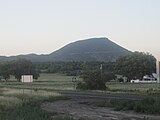Capulin Volcano National Monument
Template:Geobox Capulin Volcano National Monument is a U.S. National Monument located in northeastern New Mexico which protects and interprets an extinct cinder cone volcano that is part of the Raton-Clayton Volcanic Field. A paved road spirals around the volcano and visitors can drive up to a parking lot at the rim. Hiking trails circle the rim as well as lead down into the mouth of the volcano. The monument was designated on August 9, 1916 and is administered by the National Park Service.
The visitor center features exhibits about the volcano and the area's geology, natural and cultural history, and offers educational programs about volcanoes. There is also a video presentation about the volcano. The name capulin comes from a type of black cherry, Prunus serotina, that is native to southern North America.
Description
From the National Park Service:[1]
Capulin Volcano National Monument is a well-preserved, relatively young (58,000 to 62,000 years old), symmetrical cinder cone. It rises steeply from the surrounding grassland plains to an elevation of 8,182 feet above sea level. The irregular rim of the crater is about a mile in circumference and the crater about 400 feet deep.
Capulin Volcano is one of the outstanding landmarks located in the northeast corner of New Mexico, where the rolling grasslands meet the foothills of the Sangre de Cristo Mountains. Capulin Volcano's highest point provides unobstructed, panoramic views of the volcanic field, distant snow-capped mountains, and portions of four states (New Mexico, Oklahoma, Texas and Colorado).
Capulin Volcano also offers visitors excellent opportunities for observing and understanding volcanic formation. The large volcanic field surrounding the monument contains at least 100 recognizable volcanoes, and aids visitors in gaining insights into 10 million years of the geological history of northern New Mexico.
-
The grass-covered outer slope of the cinder cone.
-
A trail leads from the parking lot to the crater floor.
-
View from the summit.
-
Panorama view from the top.
Monument History
According to the National Park Service:[2]
On January 16, 1891, Capulin Mountain was "…withdrawn from settlement, entry or other disposition under any of the public land laws, until such time as Congress may see fit to take action touching the same or until otherwise ordered by competent authority…"
On August 9, 1916, President Woodrow Wilson set Capulin aside as a U.S. National Monument by Presidential Proclamation No. 1340, to preserve "…a striking example of recent extinct volcanoes … which …is of great scientific and especially geologic interest…"
Public Law 87-635, 87th Congress, S.2973, September 5, 1962, amended the proclamation to "…preserve the scenic and scientific integrity of Capulin Mountain National Monument…" because of the significance of Capulin Volcano.
On December 31, 1987, Congress changed the Monument's name from Capulin Mountain National Monument to Capulin Volcano National Monument by Public Law 100-225 (101 Stat. 1547).
-
Capulin Volcano, viewed from the west (1909)
-
Congealed lava flows, viewed from the top of Capulin Volcano (1909)
-
Capulin Volcano, viewed from the west (1916)
-
Capulin Mountain as seen from the highway near dusk (2010)
See also
- Sierra Grande to the southeast
- Johnson Mesa to the northwest
- Eastern New Mexico
- Black Mesa (Oklahoma) to the northeast
References
External links
- Volcanoes of New Mexico
- National Park Service National Monuments in New Mexico
- Museums in Union County, New Mexico
- Natural history museums in New Mexico
- Geology museums in New Mexico
- Cinder cones of the United States
- Extinct volcanoes
- Pleistocene volcanism
- Mountains of New Mexico
- Protected areas established in 1916
- Protected areas of Union County, New Mexico
- Landforms of Union County, New Mexico







